
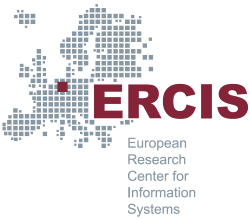
JiTT@OS2017
Why and how not to lecture
What and Why
A Revelation
- Lectures in module “Computer Structures and Operating Systems” in summer 2016
- I made intense use of a classroom response system
- Quizzes testing students’ understanding during classes
- I made intense use of a classroom response system
- Quiz results continuously worse than anticipated
- Yet, students did not engage in discussion
- Then I did this poll:

What is the Problem?
- Regardless of my satisfaction with my lectures,
learning outcomes are unsatisfactory
- Yet, students do not seem to care
- Notice: I would not have known without classroom response system…
- What about your classes?
- Asides
- Not an issue: Students liked my classes
- Average grade in end-of-term evaluation was 1.8
- A separate issue: Class participation
- At most 50% of students taking exam attend classes; typically about a third
- Not an issue: Students liked my classes
Are Lectures a Waste of Time?
I think so.
- Others agree
Cognitive Load Theory [DeJ10]
- Capacity of working memory (aka short-term memory) is limited
- Learning material and processes come with different
cognitive loads
- Germane loads, associated with learning processes
- Intrinsic loads, related to difficulty/complexity of topics
- Element interactivity is central factor
- Extraneous loads, related to suboptimal instructional procedures
- If combined loads too high, cognitive overload of working memory hinders learning
Cognitive Load Impact
Either I need to reduce the intrinsic load
- (Lecture about “easier” topics, less topics)
- Or I need to move the locus of learning
- JiTT
- Flipped classroom
- (Reading assignments did not work, experiment in Master course just ended)
JiTT@OS as Digi-Fellowship
- Digi-Fellowship
- Introduce Just-in-Time Teaching
- Lectures on Operating Systems (part of CSOS)
JiTT Big Picture
Just-in-Time Teaching
- http://jittdl.physics.iupui.edu/jitt/
- Teaching and learning strategy [NPG+99],[MSN16]
- Core idea: Feedback cycle among students and instructors
- Students work through educational resources and submit
solutions to pre-class assignments
- They discover challenges throughout the term
- Instructors correct students’ solutions before class meeting
- Instructors adjust class topics just-in-time
- Students work through educational resources and submit
solutions to pre-class assignments
JiTT Benefits
- Students learn actively and continuously
- Based on their individual background
- At their individual pace
- Instructors identify difficulties, misunderstandings, and incorrect
prior beliefs
- And react accordingly just-in-time
- Shared class time is used more efficiently and more effectively
- Focus on interesting aspects
- Interaction instead of passive listening
JiTT for OS 2017
OS 2017 in Numbers
- 106 – 91 students took mandatory graded tests
- Typically, 45 – 30 students attended class meetings
- 86 students wrote end-of-term exam, 61 passed
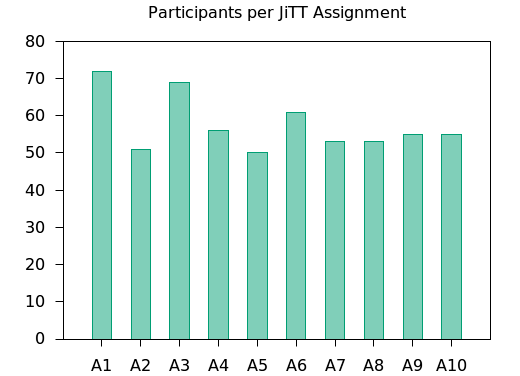 79 students worked on at least one JiTT assignment (out of ten)
79 students worked on at least one JiTT assignment (out of ten)
- 28 on all
- 51 on eight or more
On JiTT Assignments
- Lots of work
- Creation of questions as well as correction of answers
- In particular, redundant work for JiTT corrections when
similar problems required similar feedback
- (Also, individual students are blocked by similar challenges)
- Next installment may use online tool for discussions
- In particular, redundant work for JiTT corrections when
similar problems required similar feedback
- Creation of questions as well as correction of answers
- Worth the effort
- Lots of surprising answers/insights
- Less surprising, yet highly relevant: Knowledge from prior/related classes may be missing
- I improved/extended every presentation after learning about
students’ difficulties
- From wording to sequences of new slides
Particularly Noteworthy Answers
- Making me happy
- Suggestion of in-class game
- Various presentations/animations of algorithms
- Shocking
8 out 56 students found it hard or impossible to locate the text for the following task:
“Submit your solutions to Exercise 2.3 of [Hai17].”
Students’ Understanding (1)
Do you believe that JiTT assignments combined with in-class meetings improve or decrease your understanding of course topics compared to traditional lectures?

Students’ Understanding (2)
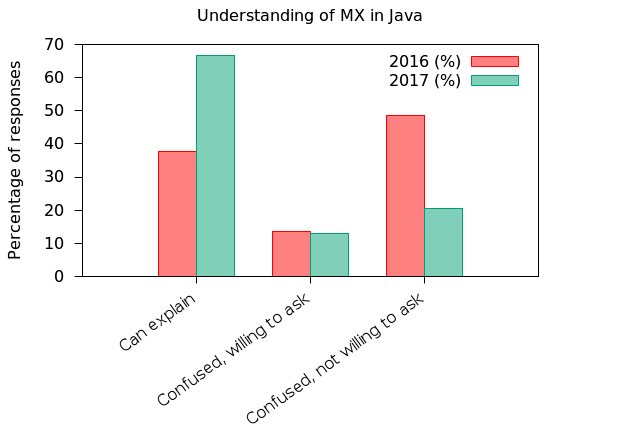
Side note: In absolute numbers, 66% in 2017 amounts to 36 students.
37 students scored 75% or more in a related exam question.
Students’ Understanding (3)

Workload
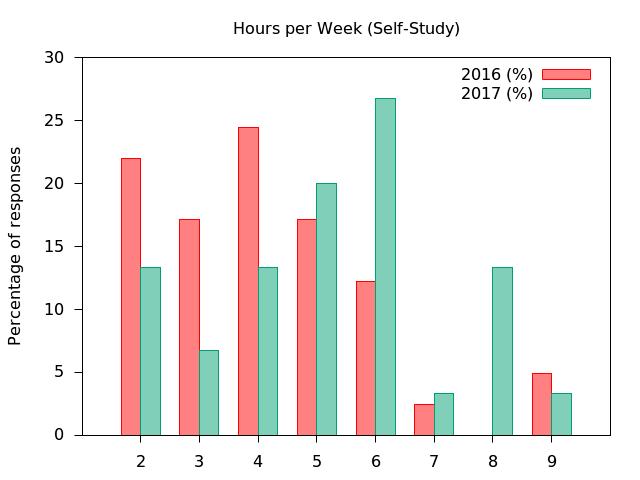
Average increased from 4.1 to 5.2 hours per week (for module with 6 hours per week)
Class Evaluation
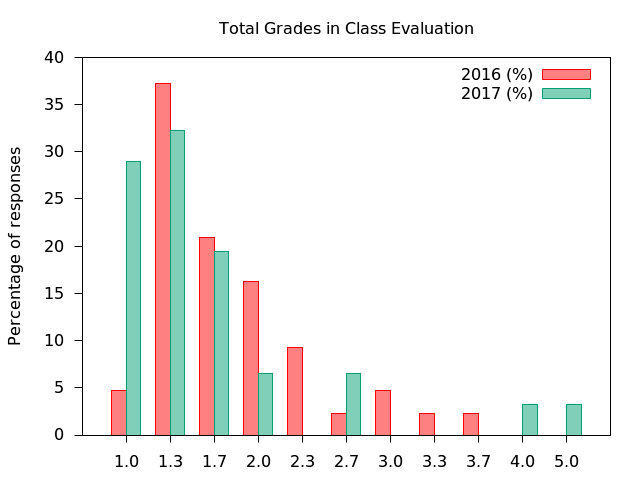
Average improved from 1.8 to 1.6; however, two outliers
Conclusions
Findings
- Subjective
- Much more fun in class
- (Traditional lectures lost fun for me)
- Surprises out of class
- Much more fun in class
- Objective
- Students who participate like JiTT
- Exams results without significant change from previous year
- However, with correlation to JiTT activities
Announcement by DBIS Group
- We will flip courses starting in January 2018
- Data Integration
- CSOS
- MIS/DWH to be discussed
Future Work
- How to increase student participation?
- In particular, less successful ones?
- Roll out JiTT
- In your courses, too?
- (Broader exposition to JiTT might change students’ mindsets…)
- Term structure in studies?
- Fewer courses in parallel, each one more intense
- (Avoid simultaneous workload peaks of independent courses)
Different Topic: OER
- Open educational resources (OER)
- Teaching material under free licenses such as Creative Commons
- Five Rs (retain, reuse, revise, remix, redistribute; originally four [HWSJ10])
- Self-study presentations for Operating Systems as OER
- Teaching material under free licenses such as Creative Commons
- Created with my own software, emacs-reveal
Discussion
THE IS RESEARCH NETWORK
Bibliography
- [SR17] Schwartzstein & Roberts, Saying Goodbye to Lectures in Medical School—Paradigm Shift or Passing Fad?, New England Journal of Medicine 377(7), 605-607 (2017). http://dx.doi.org/10.1056/NEJMp1706474
- [FEM+14] Freeman, Eddy, McDonough, Smith, Okoroafor, Jordt & Wenderoth, Active learning increases student performance in science, engineering, and mathematics, Proceedings of the National Academy of Sciences 111(23), 8410-8415 (2014).
- [DeJ10] De Jong, Cognitive load theory, educational research, and instructional design: some food for thought, Instructional science 38(2), 105-134 (2010).
- [NPG+99] Novak, Patterso, Gavrin & Christian, Just-in-Time Teaching: Blending active Learning and Web Technology, Prentice Hall, 1999.
- [MSN16] McGee, Stokes & Nadolsky, Just-in-Time Teaching in Statistics Classrooms, Journal of Statistics Education 24(1), 16-26 (2016).
- [Hai17] Hailperin, Operating Systems and Middleware – Supporting Controlled Interaction, Revised edition 1.3, 2017. https://gustavus.edu/mcs/max/os-book/
- [HWSJ10] Hilton, Wiley, Stein & Johnson, The four ‘R’s of openness and ALMS analysis: frameworks for open educational resources, Open Learning 25(1), 37-44 (2010).
- [Roc01] Rockley, The Impact of Single Sourcing and Technology, Technical Communication 48(2), 189-193 (2001).
License Information
Except where otherwise noted, this work, “JiTT@OS2017: Why and how not to lecture”, is © 2017 Dr. Jens Lechtenbörger, under the Creative Commons license CC BY-SA 4.0.
In particular, trademark rights are not licensed under this license. Thus, rights concerning third party logos (e.g., on the title slide) and other (trade-) marks (e.g., “Creative Commons” itself) remain with their respective holders.


